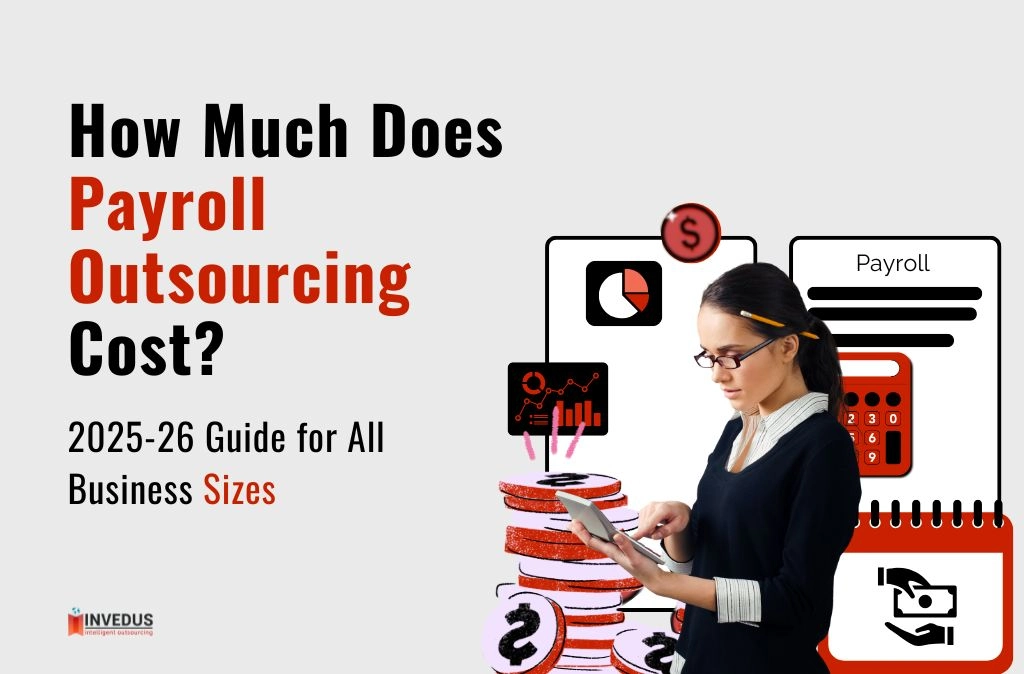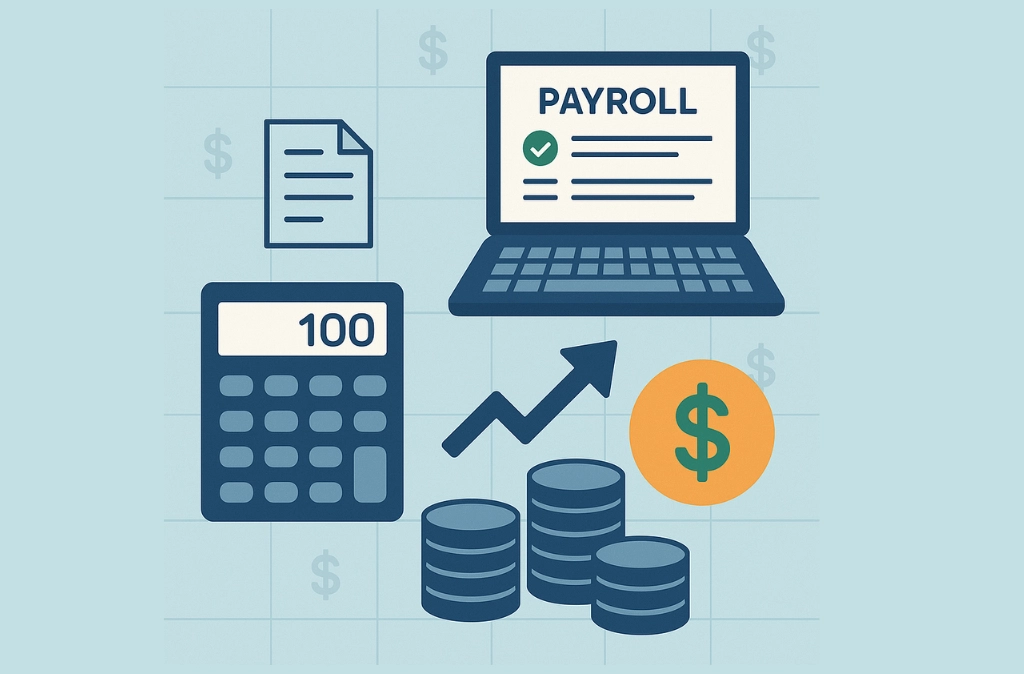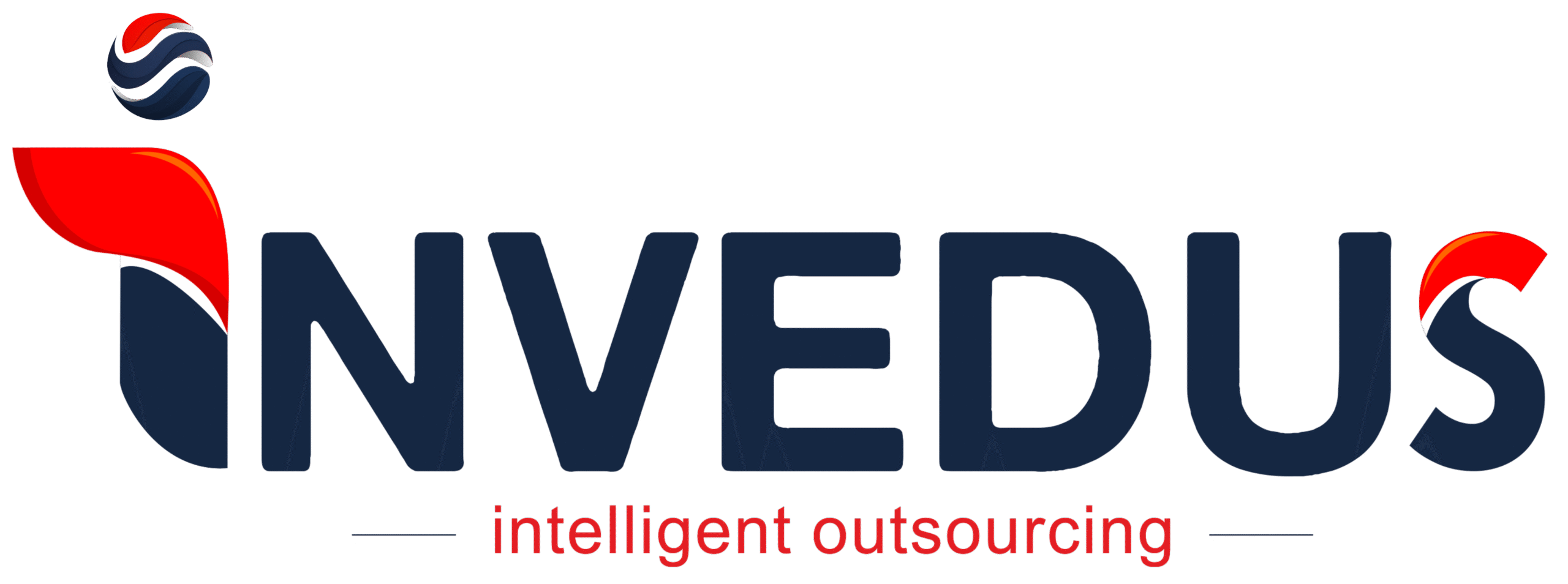
How Much Does Payroll Outsourcing Cost? [2025-26 Guide for All Business Sizes]
Why does this question matter more than ever?
Payroll is a mission-critical process that keeps your team paid, your taxes filed, and your business compliant. As a business grows, complications also rise i.e. more employees to pay, more states or regions to stay compliant in, and a greater chance that something critical gets missed.
For many companies, managing payroll in-house or patching together different payroll services and software tools starts out feasible but quickly turns into a drain on time, energy, and budget.
That’s why more business owners are asking a smart question: “How much does outsourcing payroll cost?” The answer isn’t one-size-fits-all. It depends on what you mean by “outsourcing.”
For example, are you simply signing up for access to a payroll platform? Or are you offloading the entire responsibility to a skilled team that runs the operation for you, end to end?
This blog will tell you everything you need to know, such as real pricing ranges and common cost structures, hidden fees that most companies don’t see coming, and why outsourcing payroll to a dedicated human team like the model offered by Invedus might deliver better value and fewer headaches than relying on software alone.
If you’re wondering what outsourcing payroll actually costs and what you’re really getting for your money, keep reading!
What Payroll Outsourcing Actually Includes (and What It Might Not)
When you think about outsourcing payroll, it’s easy to picture a single solution, but in reality, there are different levels of support. What you get (or don’t get) can make a big difference in cost, time, and effort.
Some providers just run the basics, like cutting checks, handling tax filings, and sending over standard reports. Others offer more hands-on help or even take the entire payroll function off your plate. If you’re not clear on which model you’re getting, you might end up paying for more and still doing too much yourself.
Take a quick look to understand how the three main models work:
| Model | Who Does the Work | What You Manage | Best For |
|---|---|---|---|
| DIY Software(e.g., QuickBooks, Gusto) | You | Everything: setup, taxes, filings | Very small teams or solo founders |
| Shared Portals(e.g., Paychex, ADP) | Provider + You | Data entry, review, some compliance | Mid-size teams with basic needs |
| Fully Delegated Team(e.g., Invedus) | A dedicated team (not software) | Nothing—your team handles it end to end | Growing businesses that want payroll off their plate |
This matters because outsourced payroll costs aren’t just about the monthly fee. You have to see how much work gets offloaded and how much still lands on your desk. So if you’re looking for payroll services for small businesses that truly save time and reduce administrative hassle, you have to find a provider after choosing the right model.
Related Reading: Reasons to Outsource Your Payroll Services
How Is Payroll Outsourcing Typically Priced?
When it comes to payroll outsourcing, most providers don’t publish a universal rate. They follow a few common pricing models. Knowing which one you’re signing up for can save you from surprises later.
Here are the four most widely used pricing structures in the payroll space:
1. Base Fee + Per Employee
This is the most common setup. You’re charged a fixed monthly fee (often $30 to $150), plus an additional charge for each employee, usually between $4 and $15.
Example: Gusto starts at $40/month + $6 per employee. ADP’s plans also follow a similar format, but they often require a custom quote.
This model works well for companies with predictable headcounts and simple payroll runs. Though the total cost of outsourcing payroll this way can rise quickly as you scale or add complexity.
2. Per Payroll Run
In this model, you pay a fee each time payroll is processed. It’s often paired with a per-employee charge as well. This structure is more common with older systems or for companies that pay infrequently.
Example: Paychex offers per-run pricing for some legacy plans. You might pay $50 per run + $2 per employee.
It can work for businesses with monthly or semi-monthly pay schedules, but for weekly or biweekly payroll processing, it adds up fast.
3. PEPM (Per Employee Per Month)
Rather than billing per run, this model charges a flat monthly rate for each employee, regardless of how often you process payroll.
Example: Some Gusto and Paychex plans follow this format, e.g., $6–$12 per employee/month with unlimited runs.
This is great for companies that run frequent payrolls or issue bonuses, commissions, or off-cycle payments regularly.
4. Percentage of Total Payroll
Less common, but still used, mostly in bundled HR + payroll packages. Instead of a flat rate, providers take 1–3% of your total payroll volume.
Example: Some enterprise-level solutions or professional employer organizations (PEOs) like TriNet or Justworks may use this model when offering a full suite of HR, benefits, and payroll services.
While it offers flexibility, it can become costly as payroll totals grow, chiefly with high earners on your team.
Worth noting: All of these models are used mainly by software-driven or shared-service payroll providers. If you’re working with a fully delegated team like the offshore professionals Invedus provides, these structures don’t apply in the same way. Instead, you’re paying for managed capacity, not just clicks or pay runs.
How Much Does It Cost to Outsource Payroll? (Real Examples by Business Size)

Payroll outsourcing doesn’t come with a universal price tag. What you’ll pay depends on things like how many people you’re paying, how often you run payroll, and how much help you actually need.
If you’re starting your own business, the numbers will look very different from a company with 100+ employees. To give you a clearer idea, here’s what the typical costs look like under two models: software-based tools (like Gusto or QuickBooks) and fully managed, delegated payroll teams (like Invedus).
| Business Size | Software-Based Range | Delegated Team Estimate | Notes |
|---|---|---|---|
| Solo / Freelancer | $50–$100/month | Not ideal | Software likely sufficient |
| 1–10 Employees | $100–$200/month | $250–$500/month | Delegated model starts here |
| 25–100 Employees | $250–$850/month | $800–$2,000/month | Better ROI with delegation |
| 100–500 Employees | $1,000–$3,050/month | $2,500–$5,000/month | Scaling without hiring headaches |
As you can see, the cost range overlaps, but the experience is very different. With payroll software, you still manage the inputs, corrections, and compliance issues. With a delegated team, the execution is entirely off your plate.
So if you’re wondering how much it really costs to outsource payroll, it comes down to this: Are you just handing off a few tasks or the whole job? If you’re looking to stop thinking about payroll altogether, having a team take care of it end-to-end usually makes a lot more sense, largely as your business grows.
Know Your Options: QuickBooks vs Xero: Is QuickBooks better than Xero for accounting in 2025-2026?
What Drives Payroll Outsourcing Costs Up (and Down)?
There’s no fixed number when it comes to payroll outsourcing because what you pay depends on how complex your payroll really is.
Here’s a look at what tends to increase or reduce your outsourcing payroll cost:
Things That Push The Cost Of Payroll Service Up
- More employees: Most pricing models charge per head, so team size matters.
- Frequent pay runs: Weekly payrolls cost more than monthly ones.
- Operating in multiple states or countries: Each region adds its own tax rules and filing requirements.
- Add-ons: Services like ACA reporting, W-2s &1099s, or HR system integrations usually come with extra fees.
- Paper checks or garnishments: Physical mail, court-ordered deductions, and custom payroll reports take more time and money to manage.
Things That Help Keep Cost For Payroll Services Down
- Annual contracts: Some providers offer discounts if you commit for a year.
- Bundled services: Combining your HR and payroll under one provider can often lower total spend.
- Delegated offshore teams: With a provider like Invedus, your payroll is run by skilled offshore staff at a fraction of the cost of domestic operations.
- Direct deposit: Ditching paper checks not only speeds things up but also trims processing fees.
Two providers might give you the same quote upfront, but the actual cost can play out very differently. If you’ve got a small team, run payroll twice a month, and don’t deal with multiple states or manual check handling, you’ll pay a lot less than someone managing weekly runs across five states with custom reports.
Additional Costs People Often Miss
One of the most frustrating parts of outsourcing payroll? The surprise fees.
Plenty of providers advertise simple pricing until you start asking for things that aren’t part of the base package. Here are some of the most common fees that often slip under the radar:
- Setup & onboarding: Some providers charge a one-time fee to migrate data, configure the system, or get your first payroll live.
- Year-end filings: Forms like W-2s, 1099s, and 941s aren’t always included. Many charge per form or as a separate package.
- Extra pay runs: Need to run off-cycle payroll for bonuses or corrections? That might come with an added cost.
- Customer support upgrades: Basic support might be slow or limited. If you want faster help or a dedicated rep, expect to pay more.
- Termination or data access fees: Want to switch providers or export historical payroll data? That could come with a closing bill.
If you’re comparing providers, make sure to ask what’s not included. The real outsourcing payroll services cost is often in the fine print.
For the most part, this is important for small business payroll, where every dollar (and every task) counts. A quote that looks cheaper upfront could end up costing more once you factor in the support and services you actually need.
Get further insights: The Hidden Costs of In-House Accounting
In-House Payroll vs. Software vs. Fully Outsourced (Comparison Table)
When weighing the cost to outsource payroll, it’s easy to assume software is the cheapest option. Though the true cost also includes the time, risk, and manual effort you keep on your plate.
Here’s how the three main approaches stack up:
| Method | Avg. Cost | Billing Cycle | Admin Burden | Best For |
|---|---|---|---|---|
| In-House Staff | $54K–$78K | Monthly/Annual (Salary) | Very High | Large companies with internal HR/payroll teams |
| Payroll Software | $500–$3,000 | Annual Subscription | High | DIY-savvy small teams |
| Delegated Team (Invedus) | $2,500–$5,000 | Monthly Retainer | Very Low | Businesses that want done-for-you payroll |
While a software might look like a low cost payroll services option at first, it often shifts the burden of compliance and accuracy onto your team. If you’re looking for true relief, the cost of outsourcing payroll services through a dedicated team can be a smarter long-term move.
How Do You Estimate Your Payroll Outsourcing Cost Per Employee?
No matter which route you take, that is, software or a human-led payroll team, your actual payroll costs per employee can vary quite a bit. It all comes down to how often you pay your team, how many people are on payroll, and how much support you’re getting (or not getting) behind the scenes.
For Payroll Software (DIY or Shared Portal)
Most providers follow a basic formula:
(Base Fee) + (Number of Employees × Per-Employee Fee × Payroll Runs per Month)
Example:
Let’s say your provider charges a $40 monthly base fee, $6 per employee, and you run payroll biweekly (2 times/month) for 10 employees.
→ $40 + (10 × $6 × 2) = $160/month
That’s $1,920 per year in payroll costs, not including additional expenses such as year-end filings or customer service outsourcing upgrades that businesses may need.This setup might work for small teams with predictable cycles. Though for fast-growing companies, these payroll costs for small businesses can escalate quickly if you’re adding staff or handling multiple pay periods.
For Fully Delegated Payroll (e.g., Invedus)
There’s no fixed formula here. The cost is estimated based on:
- Business size (headcount & growth)
- Scope of services (compliance, filings, benefits, etc.)
- Staffing needs (how many people we deploy on your account)
Example:
A business with 25–50 employees might pay $3,000–$4,500/month for full delegation where the entire function is handled by a human team, not a platform. That includes payroll runs, taxes, compliance, filings, and ongoing adjustments.
While it may sound higher upfront, delegated models absorb overhead, save time, and reduce hidden payroll outsourcing costs (like misfilings, delays, or internal training).

Payroll Costs by Country: Employer Obligations You Still Need to Cover
When outsourcing payroll, it’s important to remember that payroll outsourcing costs don’t eliminate your core employer obligations.
In every country, businesses are still responsible for payroll cost per employee in the form of taxes, insurance, and social contributions, regardless of whether they run payroll internally or hire a provider.
If you’re hiring globally or comparing countries for delegation, here’s what payroll-related employer expenses typically look like:
| Country | Estimated Employer Payroll Costs (% of Gross Salary) | What’s Included |
| United States | 7.65% | Social Security and Medicare (FICA taxes) |
| Canada | 10%–12% | Canada Pension Plan (CPP) + Employment Insurance (EI) |
| Australia | 9.5%–10% | Superannuation contributions |
| United Kingdom | 13.8% | Employer National Insurance |
| Spain | 30%–35% | Social security contributions for pensions, healthcare, unemployment, etc. |
These costs are independent of the payroll provider’s fee. Even if you hire one of the best payroll outsourcing companies, these contributions remain your responsibility.
Knowing the cost of payroll per employee in each region is useful when budgeting for international expansion or choosing a provider with global capabilities.
Just remember: an outsourcing partner like Invedus can help you stay compliant across borders without adding internal workload.
Is Delegating Payroll Worth It?
If you’re still manually managing payroll or toggling between software, spreadsheets, and tax deadlines, it’s costing more than you think: In time. In compliance risk. In opportunity cost.
When you delegate payroll, you stop multitasking and start scaling. Here’s what you actually gain:
- No overhead: no HR hire, no training, no tools
- No software: no dashboards to learn or licenses to renew
- No stress: just accurate, on-time payroll handled by real people
For the cost of a single HR hire, you get a full-function payroll team working behind the scenes filing taxes, handling employee pay, managing reports, ensuring compliance, and more.
That’s what we do at Invedus.
We’re not just another tool. We’re one of the best payroll outsourcing companies for businesses that want reliable, low-cost payroll services without giving up control or visibility.
So, is outsourcing payroll cost-effective?
If you’re ready to stop “managing payroll” and start focusing on actual business growth, yes, it is. We’ll make sure of it. Contact us today!
Frequently Asked Questions on Payroll & HR Outsourcing Costs
How much do payroll consultants charge?
Average payroll cost per employee is between $5 and $17 per month for consultants, and there are different pricing structures based on the per-user model. You may also have to sign monthly and annual contracts.
How much does HR outsourcing cost?
For full-service HR (benefits, compliance, hiring), costs usually range from $50 to $200 per employee/month. But if you outsource to offshore teams like Invedus, you can often get the same support for significantly less.



